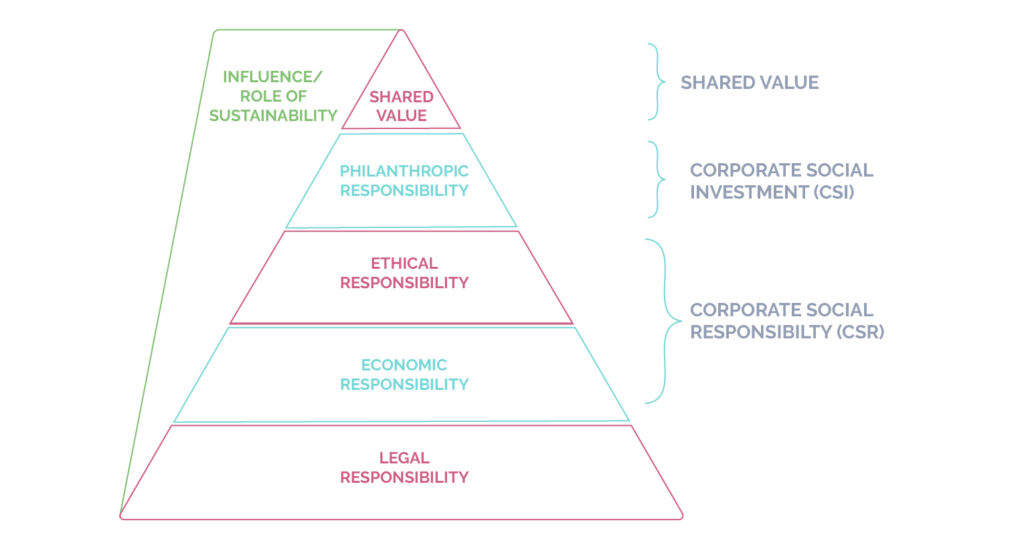10 minute read
Hierarchy of corporate responsibility

The foundation of the pyramid starts with a business’s legal responsibility. This covers the legal structure and regulatory framework which a business needs to adhere to in order to operate. It also includes the reporting and disclosure requirements in a given market and for an asset manager, the fiduciary duty to clients.
The next level up is the business’s economic responsibility. This includes their responsibility to seek financial performance on behalf of clients and other stakeholders, including shareholders, employees and possibly the communities in which the business operates.
Next comes ethical responsibility. the specifics here start to vary depending on the business’s own values. This category would include commitments to transparency, internal business practices and environmental, social and sustainability policies. An example here might be policies and actions around Diversity, Equality and Inclusion (DE&I). This might also include a commitment to move to a model of shareholder capitalism over stakeholder capitalism.
Philanthropic responsibilities constitutesthe next level up and covers the contributions that a business makes to the communities and environments in which it operates. This is sometimes referred to as corporate social investment (CSI) and refers to activities that fall outside of a business’s usual operations, and are carried out explicitly for the purpose of doing good for society or the environment, often to help develop and nurture communities. For example, this might include UK based companies contributing to charities that carry out reforestation projects in the Amazon rainforest, or an asset manager contributing to cancer research.
Finally, the top of the pyramid is the most aspirational and as such may not be deemed a responsibility by all, bar the most sustainability-oriented businesses. Shared value is a business concept developed by Michael Porter1 where the policies and operating practices of a business work towards enhancing their competitiveness and a profitability, while simultaneously advancing the economic and social condition in the communities in which it operates. This might include aligning business practices and strategies to frameworks such as the United Nations Sustainable Development Goals and engagement at an industry and governmental level to achieve these goals.

The green wedge represents the influence and role of sustainability at each level of the pyramid. It’s least obvious or influential at the level of legal responsibility, as many of the relevant sustainability issues are built into legal and regulatory requirements. For example, an asset manager’s responsibility not to falsely advertise potential financial returns has long been written into regulation and divergence from this is punishable.
Not all businesses will agree with this order of priority. You might consider your ethical responsibility to come before your economic responsibility. The reality is that for many, particularly multi-faceted or longer standing businesses with several moving parts, philanthropic considerations come before ethical ones.
Shared value
Shared value is the ‘policies and operating practices that enhance the competitiveness of a company while simultaneously advancing the economic and social conditions in the communities in which it operates. Shared value creation focuses on identifying and expanding the connections between societal and economic progress.”2
 Read: Michael E Porter & Mark R Kramer, Harvard Business Review, Creating Shared Value – How to reinvent capitalism – and unleash a wave of innovation and growth pgs 1-7
Read: Michael E Porter & Mark R Kramer, Harvard Business Review, Creating Shared Value – How to reinvent capitalism – and unleash a wave of innovation and growth pgs 1-7
Key points:
- The approach to value taken by many companies over the last few decades is outdated – a narrow view that prioritises short-term financial performance and neglects the most important customer needs and the broader influences that determine their longer-term success.
- The principle of shared value involves creating economic value in a way that also creates value for society by addressing its needs and challenges.
- Shared value is not about social responsibility, philanthropy or sustainability, but a new way to achieve economic success.
- Capitalism is an unparalleled vehicle for meeting human needs, improving efficiency, creating jobs, and building wealth. But a narrow conception of capitalism has prevented business from harnessing its full potential to meet society’s broader challenges.
- Corporations driving to achieve shared value will have the opportunity to drive the next wave of innovation and productivity.
- Business and society have long been pitted against each over due to the misconception that businesses must temper their economic success if they are to provide societal benefits.
- Externalities arise when firms create social costs that they do not have to bear, such as pollution – society must impose taxes so that firms recognise these actions. This approach had contributed to firms not giving environmental or societal issues further thought.
- Solving social problems has long been deemed to be the role of governments and NGOs, with corporate responsibility programmes often arising as a means to bolster reputation.
- The concept of shared value recognizes that societal needs, not just conventional economic needs, define markets. It also recognises that social harms or weaknesses can create internal costs for firms.
- Shared value is not about sharing the value already created (a redistribution approach) but about expanding the total tool of economic and social value.
- At a basic level, the competitiveness of a company and the health of the communities around it are closely intertwined – societies rely on companies for employments and to provide goods and services, companies rely on societies for employees and customers. Public policies that undermine business productivity and competitiveness are therefore counterproductive.
- The old narrow view of capitalism held by Milton Friedman supposes that business contributed to society by making profit, which supports employment, wages, purchases, investments, and taxes.
- This was not always the case, many companies once took on a broad range of roles in their communities, however as other social institutions developed, these roles were made redundant and firms narrowed their efforts to pure profit production
- As the world became more globalised many large companies also lost a sense of belonging to any one place.
- Strategy theory holds that to be successful, a company must create a distinctive value proposition that meets the needs of a chosen set of customers. However, companies have overlooked opportunities to meet fundamental societal needs and misunderstood how societal harms and weaknesses affect value chains.
- There are three key ways that companies can create shared value:
- By reconceiving products and markets,
- By redefining productivity in the value chain,
- By building supportive industry clusters at the company’s locations.
Improving value in any one area gives rise to opportunities in other areas.
- The concept of shared value resets the boundaries of capitalism. By better connecting companies’ success with societal improvement, it opens up many ways to serve new needs, gain efficiency, create differentiation, and expand markets.
- Advanced economies and developing countries both have the ability to create shared value although the opportunities will differ. Opportunities will also differ across industries.
- Many consumer-oriented companies have spent a lot of time and effort creating needs to then fulfill, and have overlooked some of the most basic and genuine needs of society that need to be met.
- The concept of shared value blurs the lines between for-profit and non-profit organisations, cresting space for hybrid organisations.
There are numerous ways companies can benefit economically from contributing to the needs of society.
For example, when a firm contributes to employee wellness – employees benefit and the firm benefits from healthier employees (less absences etc).
The diagram below shows some areas where these connections can be made.

1Porter, M. and Kramer, M., 2011. Creating Shared Value. How to reinvent capitalism—and unleash a wave of innovation and growth. [online] Harvard Business Review. Available at: <https://hbr.org/2011/01/the-big-idea-creating-shared-value>.
2 Porter, M. and Kramer, M., 2011. Creating Shared Value. How to reinvent capitalism—and unleash a wave of innovation and growth. [online] Harvard Business Review. Available at: <https://hbr.org/2011/01/the-big-idea-creating-shared-value>.
